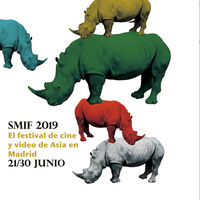The New Spanish Cinephilia goes to Asia
Asian cinema has become an important reference for Spanish cinephiles during the last years. It is a curious phenomenon considering that Spanish distributors and exhibitors haven’t paid too much attention to films produced in countries from the Far East. With the exception of the well known Japanese film classics or the ephemeral boom of Chinese cinema at the beginning of the 90’s, the most recent cinema from Taiwan, Thailand, Hong Kong or Japan is still unfamiliar for Spanish moviegoers. But alternate ways for watching all these films have allowed that an important sector of Spanish cinephilia be well aware of the last trends of Asian cinema.The gradual introduction of this new sensibility toward Asian cinema has its origins within the limits of domestic entertainment. Enthusiastic fans of Hong Kong martial arts films, John Woo’s violent thrillers, Japanese horror movies and anime fantasies found on video and DVD a better way for getting access to all those films they cannot see in movie theaters. Maybe this kind of movies were not very appreciated by film critics, but they have generated some kind of ‘parallel’ cinephilia. The critical reputation that John Woo or Johnnie To have nowadays, the influence of oriental films in Hollywood (from Tarantino to The Matrix), the best film award for Hayao Miyazki’s Spirited Away in Berlin Film Festival or the habitual presence of such directors as Satoshi Kon, Mamoru Oshii or Katsuhiro Otomo in international film festivals are proofs of the increasing interest that Asian film culture is obtaining right now in the world.
In Spain, on the contrary, DVD is still the most useful instrument for this new cinephilia who has discovered Japanese cinema not with Kurosawa or Mizoguchi, but with Shinya Tsukamoto, Takashi Miike, Hideo Nakata or Isao Takahata. Japanese anime is still underrated by Spanish distributors who consider that animation films are ‘just for kids’: the latest masterpieces by Oshii, Kon or Rin Taro were released directly in DVD, forcing the Spanish fans to see these films in their homes.
The same happens with the works of so important names in contemporary cinema as Edward Yang, Hou Hsiao-hsien, Tsai Ming-liang, Hong Sang-soo, Hirokazu Kore-eda, Naomi Kawase, Apichatpong Weerasethakul, Penek Ratanaruang or Jia Zhangke: very few of their films have been theatrically released in Spain. In this desolate scenario, the Spanish cinephiles have to find another ways to reach all those movies they want to see. In a certain way, their attitude is a vindication of all these despised films and a sort of ‘resistance’ against official taste and against those film critics who seem unaware of the new and daring proposals of Asian cinema.
The importance that Spanish film festivals have had in this proccess should not be forgotten. Fantastic film festivals as Sitges International Film Festival or the Semana de Terror y Cine Fantástico de San Sebastián have arisen a real fondness for oriental horror & fantastic films in Spanish moviegoers. Directors like Park Chan-wok, Kiyoshi Kurosawa and Takashi Miike or film stars like Anthony Wong and Chiaki Kuriyama attended Sitges Film Festival, meanwhile Shunya Tsukamoto and Teruo Ishii were invited to San Sebastián. Gijón International Film Festival organized retrospectives of Seijun Suzuki’s and Tsai Ming-liang’s work, Satoshi Kon was a special guest of Madrid’s animation film festival Animadrid and Las Palmas International Film Festival has devoted retrospectives and publications to Asian cinematographies such as Japanese, Thai, Korean or Indian. On the other hand, several magazines and websites in Spanish focus on Asian cinema. CineAsia is the first Spanish publication entirely devoted to films from all over Asia, and Letras de Cine publish special numbers about all those oriental directors that the long print magazines always forget. Spanish websites like www.miradas.net and www.trendesombras.com also pay special attention to Asian cinema. And several Spanish DVD companies (Manga Films, Notro Films, Versus Entertainment) have significant Asian titles in their catalogues.
The new interest for Asian cinema in Spain is a perfect example of how a new kind of public has imposed his preferences over the traditional Spanish distribution and exhibition structures. A public who grew up with the video and DVD and whose cinematographic taste was forged by visionary film festivals who understood the impact of Asian cinema in film world today. Meanwhile Spain is deeply involved in a boring debate about national and europeans films versus Hollywood blockbusters, this new cinephilia has found a ‘third way’, a breaking point toward Far East that enables them to recover the passion for the feats and beauties of contemporary cinema. Phenomena like DVD or Internet (through on-line shops which offer DVD imports from Asia) have democratized a process which always have been in the whimsical hands of distributors and exhibitors. Now the cinephiles can create their own ‘alternate programming’ far away from the tyranny of movie theaters and film critics.
by Roberto Cueto
-----------------------
ROBERTO CUETO (Madrid, 1965) is Associate Professor of History and Theory of Cinema in Universidad Carlos III of Madrid (Spain) and film critic in the weekly magazine El Cultural. He is also author of several books on film history and has contributed with articles to several publications devoted to Asian cinema: Seul Express: La renovación del cine coreano, El principio del fin: Tendencias y efectivos del novísimo cine japonés, Dibujos en el vacío: Claves del cine japonés de animación, Nuevas miradas del cine asiático or Nuevo cine coreano.
Similar content
By Kerrine Goh
30 May 2008
from - to
20 Jun 2019 - 30 Jun 2019
from - to
17 Oct 2013 - 14 Feb 2014
from - to
27 Feb 2014 - 03 Mar 2014
from - to
02 Nov 2017 - 12 Nov 2017
By culture360
24 Jul 2019





